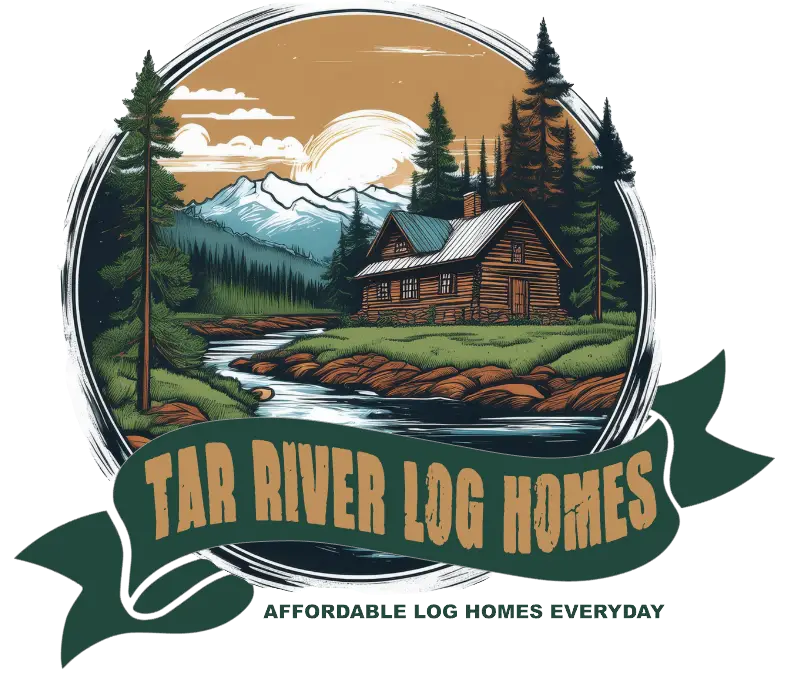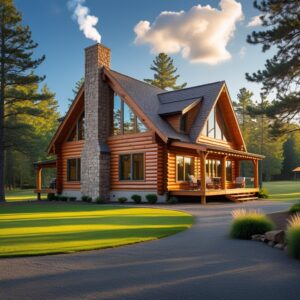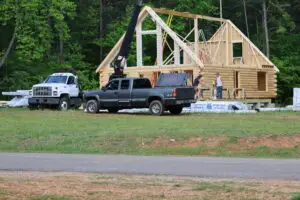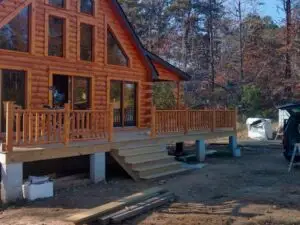Building a log home doesn’t have to drain your savings. With smart planning and careful choices, you can cut costs without cutting corners.
It starts with the basics: picking the right kit, choosing affordable materials, and sticking with a design that fits your budget. Each decision makes a difference.
At Tar River Log Homes, we focus on value. That means supplying quality logs at wholesale prices, with no hidden fees or markups. Families can build with confidence, knowing they’re getting fair prices.
The good news? Saving money doesn’t mean settling for less. With the right strategy, you can build a durable, comfortable log home and still protect your budget.
In this guide, we’ll cover the best ways to save on log homes while keeping strength, comfort, and quality in place.
Understanding Log Home Costs
If you know what drives the price of a log home, you’ll have a much easier time saving money. The kit you pick and the cabin style both have a big impact. That’s how you get the best value.
Factors Influencing Log Home Prices
A few things really move the needle on cost. Size is probably the biggest—bigger homes need more logs and more time. Wood species matters too. Eastern White Pine logs are a favorite since they’re tough but don’t cost as much as some others.
Location’s another thing. Remote sites usually mean pricier delivery and labor. Fancy features—porches, extra stories, or custom finishes—bump up the price.
Direct shipping from suppliers helps you avoid middlemen and extra fees. You get to see where your money goes.
Types of Log Home Kits
There are a few flavors of log home kits. A shell kit gives you the basics: walls, roof beams, and windows. You handle plumbing, wiring, and the inside stuff. If you’re handy, this is where you can save a lot.
A complete kit has it all—logs, doors, flooring, the works. It’s more expensive up front, but it can make life easier. And then there’s the custom kit, built to your plan with different log sizes or features. That way, you can dial in what matters and skip the rest.
Pick the kit that matches your skills, wallet, and timeline. You can find kit options that fit your needs without unnecessary markups.
Cost Differences Between Log Cabin Styles
Style can really shake up the cost. A basic one-story cabin is usually the cheapest—less material, less labor. Add a second story, a wrap porch, or high ceilings, and the price climbs.
Round log cabins tend to cost more than square or flat logs since they take extra work. Some styles need more insulation or a beefier foundation, which also adds up.
You’ll save if you stick with simple designs and standard log sizes. Flexible plans let you get what you want without paying for extras you don’t need.
Budget-Friendly Log Home Planning
A little planning goes a long way when you’re building a log home. Keeping the size right and the floor plan efficient helps you stay on budget—without losing out on the cozy, durable vibe.
Choosing the Right Log Home Size
Size really matters for your wallet. Bigger homes mean more logs, more labor, and higher heating bills. Try to stick with what you actually need.
Think about bedrooms and bathrooms—how many do you really use? Extra rooms that just collect dust are a waste. A smaller footprint cuts down on everything, including the foundation.
You can always start small and add on later. Expandable plans let you start small and add on later, so you’re not paying for empty space.
Optimizing Floor Plans for Savings
Simple floor plans keep costs down. Open layouts mean fewer walls and doors, so you save on both materials and labor. Square or rectangular shapes are usually the cheapest. Odd shapes make framing and roofing more complicated. Multi-use rooms help shrink the total area you need.
If you group bedrooms close together and limit exterior walls, you’ll save money on heating and cooling. That’s less to pay for now and later. Custom builds can be designed to fit your budget and lifestyle. No need to pay for extras you’ll never use.
Smart Material Selection
Pick the right materials and you’ll save cash without giving up quality. You want strong logs, but you don’t have to spend a fortune. Sometimes alternatives are just as good.
Selecting Affordable Logs
Look for logs like Eastern White Pine. It’s sturdy and a lot cheaper than cedar or oak. Kiln-dried logs are worth it—they shrink less and crack less, so you don’t spend on repairs later.
Buying logs by the linear foot means you only pay for what you need. Watch out for markups or hidden charges. Round logs are usually cheaper than fancy, handcrafted ones since they need less work.
Alternative Materials for Log Homes
If full logs stretch your budget too far, check out hybrid options like log siding or timber walls. Log siding gives you the look without the cost or weight.
You can also mix traditional logs with framed walls—use logs on the outside or main rooms, and go with standard framing elsewhere. That cuts wood costs but keeps the rustic feel.
Either way, you still get that warm, woodsy vibe—just without the big price tag.
Cutting Construction Expenses
Construction eats up most of the budget, especially labor and contractors. If you’re smart about these, you’ll keep more money in your pocket.
Reducing Labor Costs
Labor’s a big one. If you know your way around tools, do some of the work yourself—painting, landscaping, or finishing touches are good places to start. Try to keep the schedule tight so crews aren’t waiting around. Delays cost money.
Changing your mind halfway through? That slows things down and racks up bills. See if your contractor offers bundled services or discounts. Pre-cut materials that fit properly save time and money during construction.
Choosing Efficient Contractors
Pick contractors who know their way around log homes. They work faster and mess up less, which saves you cash.
Always get multiple quotes, but don’t just chase the lowest price. Look at what’s included, the warranty, and their past work. Ask for references from other log cabin owners.
Good communication matters. Contractors who explain their prices and timelines help you avoid nasty surprises. Stick with folks who are upfront and deliver when they say they will.
If you can, go with companies that don’t farm everything out to subcontractors—it keeps things moving and costs down.
Energy Efficiency Upgrades
Making your log home more energy efficient saves you money on heating and cooling. Focus on stopping drafts and keeping the temperature steady.
Energy Efficiency Pays Off
Well-insulated log homes can save 15–20% on annual energy costs. Adding roof, floor, and window insulation helps balance the log walls’ natural thermal mass. The Department of Energy notes that careful sealing and insulation are key to making log homes as efficient as modern framed houses.
Insulation Techniques
Insulation is key to keeping your place warm in winter and cool in summer. With log homes, you’ll want good insulation in the floors, ceilings, and sometimes between the logs.
Spray foam or rigid foam boards in floors and ceilings work better than the old fiberglass stuff. Inside, use chinking or gasket seals to stop air leaks between logs.
You don’t have to hide the wood to add insulation. Keep the logs exposed inside and insulate where it won’t show. That way, you keep the look and cut your bills.
Energy-Saving Windows and Doors
Windows and doors are the usual suspects for energy loss. Go for energy-efficient windows — double or triple pane, and low-E glass if you can swing it. Seal around frames with weatherstripping and caulk. Make sure doors fit snugly—a loose door can waste a lot of energy.
Windows and doors designed for log cabins ensure a good fit and better energy savings.”
DIY Versus Professional Services
Should you build it yourself or hire pros? That choice can save—or cost—you, depending on your skills and patience.
Pros and Cons of Building Yourself
If you’ve got some construction chops, doing it yourself saves on labor. You control the pace, and you don’t have to pay others to do the basics. Less stress, sometimes. Maybe.
But DIY means you’re on the hook for everything. Mistakes can get expensive fast. You’ll need the right tools and plenty of time. And, let’s be honest, some jobs—like roofing or electrical—aren’t great for beginners.
When to Hire Experts
Hiring pros costs more up front, but can save you from expensive mistakes. They know building codes and local rules, so you don’t get hit with fines or redos. Complicated builds or tight deadlines? Professionals keep things moving.
Bring in experts for the tricky stuff—foundation, electrical, plumbing. They’ve got insurance, which protects you and your investment. Quality materials and clear plans make working with contractors smoother and more affordable.
Long-Term Maintenance Savings
Keeping up with your log home pays off. Regular care keeps big repairs at bay, and you can find affordable options if you need to restore things down the line.
Preventative Care Strategies
Check your log home regularly for cracks, rot, or bugs. Clean gutters so water doesn’t wreck your logs.
Seal the logs every few years with a good stain or sealant. That keeps moisture out. Good airflow inside helps prevent mold and rot, too.
Tackle small issues early—fill cracks with log caulk yourself. That kind of DIY maintenance keeps labor costs down.
Affordable Restoration Options
If you do need repairs, don’t panic. Use replacement logs that match your originals to keep costs in check and maintain the look.
You can handle a lot of fixes yourself—sanding, restaining, swapping out trim—if you’ve got the tools. For bigger jobs, get quotes from trusted local folks so you don’t overpay. Wholesale-priced materials help keep restoration affordable when it’s time to spruce things up.
Financing Options for Log Homes
Paying for your log home doesn’t have to be a nightmare. There are affordable loans out there, plus grants and incentives that can help. If you know your options, you can stretch your budget further.
Securing Cost-Effective Loans
Look for loans with low interest rates and flexible terms. Some lenders specialize in log homes or alternative builds—they might say yes when others say no.
A few options to check out:
- USDA Rural Development Loans – no down payment if you’re in a qualifying rural spot
- FHA Construction Loans – government-backed, usually easier to get
- Personal or Home Equity Loans – if you already own land, these can mean lower rates
Always compare rates and ask about fees and the build timeline. Sometimes, a family-run business can hook you up with lenders who get the log home process.
Understanding Grants and Incentives
Grants and tax breaks aren’t everywhere, but they’re worth hunting for. Some states and counties want to encourage energy-efficient or rural homes.
Look for:
- Energy Efficiency Rebates – save on materials or upgrades that lower your utility bills
- Local Building Incentives – deals on permits or taxes in certain areas
- Veteran or First-Time Homebuyer Grants – if you qualify, these can help
Check government sites or ask your local housing office what’s out there. If you can stack grants with a good loan, that makes building your log home way more affordable.
Maximizing Resale Value
Making smart choices with your log home can really boost its value when you’re ready to sell. Focus on design details buyers actually want and plan updates that add profit without turning into a headache.
Design Features That Add Value
Let’s be honest—features that make your log home pop don’t have to cost a fortune. Solid wood floors? Always a hit. Energy-efficient windows? Buyers love saving on bills and maintenance.
Open floor plans just make everything feel bigger and more inviting. Covered porches or decks? People want that extra outdoor space, especially in a log home. Using quality logs like Eastern White Pine pays off since they hold up better and look great. This matters when it’s time to put up the “For Sale” sign.
Renovation Tips for Profit
Renovate in a way that fits the log home vibe and try not to go overboard compared to your neighbors. Kitchens and bathrooms—those are the big ones. Buyers notice them first.
Stick with natural wood finishes and skip painting the logs if you can. If you spot leaks or cracks, fix them early so they don’t turn into bigger headaches.
Even small things like swapping out old light fixtures or adding modern hardware can make a big difference without draining your wallet. Hold off on major remodels until you’re closer to selling—no need to pour money in too early.
Saving on Log Homes Without Cutting Corners
Building a log home doesn’t mean breaking the bank. With smart planning, affordable materials, and the right design, you can create a strong, beautiful home that fits your budget.
From choosing energy-efficient upgrades to handling some work yourself, every choice adds up to long-term savings. The key is balancing cost with quality so your home lasts for generations.
At Tar River Log Homes, we make that balance possible with wholesale pricing and straightforward support.
Ready to start saving on your log home project? Get in touch and see how affordable building can be.
Frequently Asked Questions
Saving money on a log home isn’t rocket science. It’s about smart choices—materials, energy, building plans. A little planning goes a long way for lower upkeep and better deals on kits.
What are some cost-effective strategies for building a log home?
Start with a simple design to keep things affordable. Pick standard log sizes and avoid custom cuts unless you really need them. Try to use local materials whenever you can to save on shipping.
Can you suggest ways to keep maintenance costs low for a log cabin?
Seal and stain your logs regularly to fight off weather and pests. Keep those gutters clear and fix leaks right away. Choose durable finishes so you’re not redoing it every year.
What are the best practices for energy savings in a log home?
Insulate your roof and floors with quality materials. Install energy-efficient windows and doors.
Seal up gaps to keep drafts out. Think about a modern heating system, maybe a heat pump.
How can one find affordable log home kits or packages?
Look for companies that sell straight to builders—you’ll skip the middleman markup. Compare what each kit includes—some throw in extras like foundation plans or fasteners. Ask about package deals; sometimes you can get materials bundled at wholesale prices. Some suppliers keep pricing simple and skip the fluff.
Are there budget-friendly alternatives to traditional log home materials?
Log siding or vinyl can give you the look for less. Engineered wood products are often cheaper and more stable. Try using reclaimed wood in spots to save money and add a little character.
What should I consider to reduce construction costs when planning a log home?
Go for a smaller footprint—those sprawling, complicated shapes can really drive up expenses. Make sure the site’s easy to reach; tricky access just means you’ll pay more for deliveries. If you’re handy, why not tackle some of the work yourself? It’s not for everyone, but it can help.
Find builders who know log homes inside out. It’s not worth risking rookie mistakes here. Honestly, sticking with simple designs and basic plans goes a long way. You still get that cozy log home vibe, just without blowing the budget.




